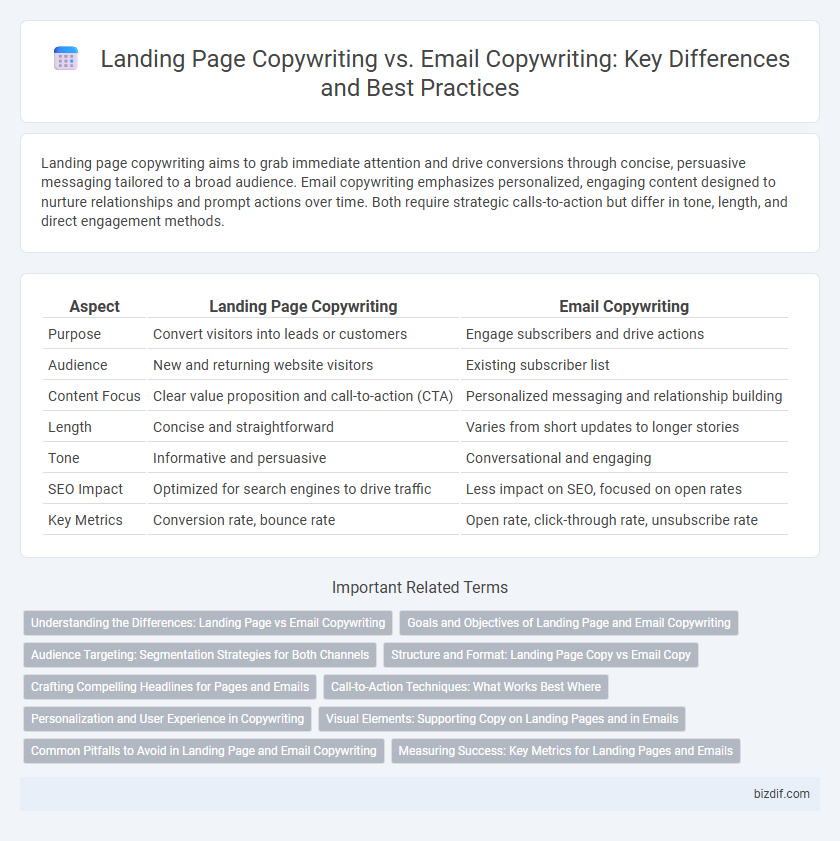Landing page copywriting aims to grab immediate attention and drive conversions through concise, persuasive messaging tailored to a broad audience. Email copywriting emphasizes personalized, engaging content designed to nurture relationships and prompt actions over time. Both require strategic calls-to-action but differ in tone, length, and direct engagement methods.
Table of Comparison
| Aspect | Landing Page Copywriting | Email Copywriting |
|---|---|---|
| Purpose | Convert visitors into leads or customers | Engage subscribers and drive actions |
| Audience | New and returning website visitors | Existing subscriber list |
| Content Focus | Clear value proposition and call-to-action (CTA) | Personalized messaging and relationship building |
| Length | Concise and straightforward | Varies from short updates to longer stories |
| Tone | Informative and persuasive | Conversational and engaging |
| SEO Impact | Optimized for search engines to drive traffic | Less impact on SEO, focused on open rates |
| Key Metrics | Conversion rate, bounce rate | Open rate, click-through rate, unsubscribe rate |
Understanding the Differences: Landing Page vs Email Copywriting
Landing page copywriting focuses on creating persuasive content designed to convert visitors by highlighting clear calls to action and benefits within a single, focused webpage. Email copywriting, in contrast, aims to engage recipients through personalized messages that build relationships and nurture leads over multiple touchpoints. Understanding these differences allows marketers to tailor their strategies effectively, optimizing conversion rates and customer engagement across channels.
Goals and Objectives of Landing Page and Email Copywriting
Landing page copywriting aims to convert visitors into leads or customers by delivering clear, persuasive messaging that drives immediate action such as signing up or making a purchase. Email copywriting focuses on building relationships, nurturing leads, and encouraging repeat engagement through personalized, targeted content that maintains audience interest. Both strategies prioritize clarity and relevance but differ in timing and interaction scope to achieve their distinct marketing objectives.
Audience Targeting: Segmentation Strategies for Both Channels
Landing page copywriting targets specific audience segments by using personalized content and clear calls-to-action tailored to visitor intent, optimizing conversion rates. Email copywriting employs segmentation strategies based on demographics, behavior, and engagement history to deliver relevant messages directly to subscribers' inboxes. Both channels rely on data-driven audience insights to enhance segmentation accuracy and improve overall campaign effectiveness.
Structure and Format: Landing Page Copy vs Email Copy
Landing page copywriting emphasizes clear, concise headlines, engaging subheadings, and strategic call-to-actions designed for quick user decisions, often formatted with bullet points and visual hierarchy to enhance readability. Email copywriting relies on personalized greetings, conversational tone, and compelling subject lines to boost open rates, formatted in short paragraphs with clickable links and clear calls to action tailored for mobile devices. Both formats prioritize user engagement but differ significantly in structure to suit their specific environments and objectives.
Crafting Compelling Headlines for Pages and Emails
Crafting compelling headlines for landing pages requires concise, benefit-driven language that immediately captures visitor attention and drives conversions through clear value propositions. Email copywriting headlines must balance brevity with personalization, enticing recipients to open messages by leveraging curiosity and relevance metrics derived from segmentation data. Both mediums rely on A/B testing headline variations to optimize open rates and engagement by analyzing click-through and bounce rates.
Call-to-Action Techniques: What Works Best Where
Landing page copywriting leverages clear, action-oriented CTAs like "Sign Up Now" or "Get Started Today" to drive immediate conversions by reducing friction and guiding users toward a single goal. Email copywriting excels with personalized CTAs that create urgency and build relationships, such as "Claim Your Offer Before It Expires" or "Reply to Secure Your Spot," optimizing engagement through tailored messaging. Understanding user intent and platform behavior is crucial for selecting CTA techniques that maximize click-through rates and conversion efficiency across both channels.
Personalization and User Experience in Copywriting
Landing page copywriting emphasizes clear, persuasive messaging tailored to visitor intent, utilizing personalization techniques like dynamic content to enhance user experience and drive conversions. Email copywriting relies heavily on personalized subject lines and segmented content to foster engagement and build relationships directly within the recipient's inbox. Both forms require deep audience understanding to deliver relevant, compelling content that anticipates user needs and behavior for optimal interaction.
Visual Elements: Supporting Copy on Landing Pages and in Emails
Visual elements on landing pages, such as images, videos, and infographics, significantly enhance supporting copy by capturing attention and reinforcing key messages. In contrast, email copywriting relies more on concise, impactful text with subtle visual cues like buttons and icons to drive engagement within limited space. Balancing visuals and copy effectively boosts conversion rates in both mediums by ensuring clarity and emotional resonance.
Common Pitfalls to Avoid in Landing Page and Email Copywriting
Common pitfalls in landing page copywriting include unclear value propositions, lack of focused calls to action, and overly complex text that reduces conversion rates. Email copywriting mistakes often involve poor subject lines, irrelevant content, and insufficient personalization, leading to low open and click-through rates. Both require precise targeting, concise messaging, and consistent brand voice to maximize engagement and effectiveness.
Measuring Success: Key Metrics for Landing Pages and Emails
Measuring success in landing page copywriting centers on metrics such as conversion rates, bounce rates, and average session duration, which directly reflect user engagement and the effectiveness of the call-to-action. Email copywriting success is primarily evaluated through open rates, click-through rates, and unsubscribe rates, providing insights into subject line appeal and message relevance. Tracking these key performance indicators enables marketers to optimize content strategies for higher ROI and improved customer engagement.
Landing Page Copywriting vs Email Copywriting Infographic

 bizdif.com
bizdif.com